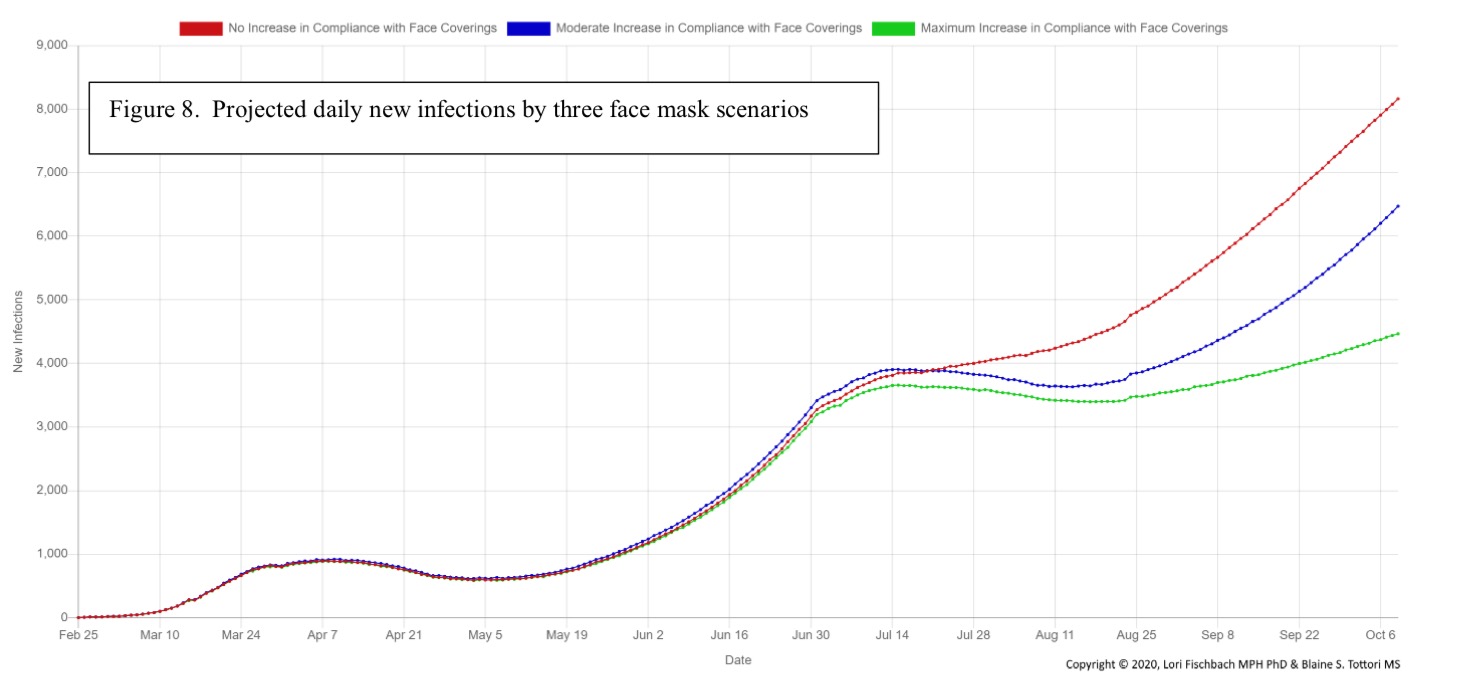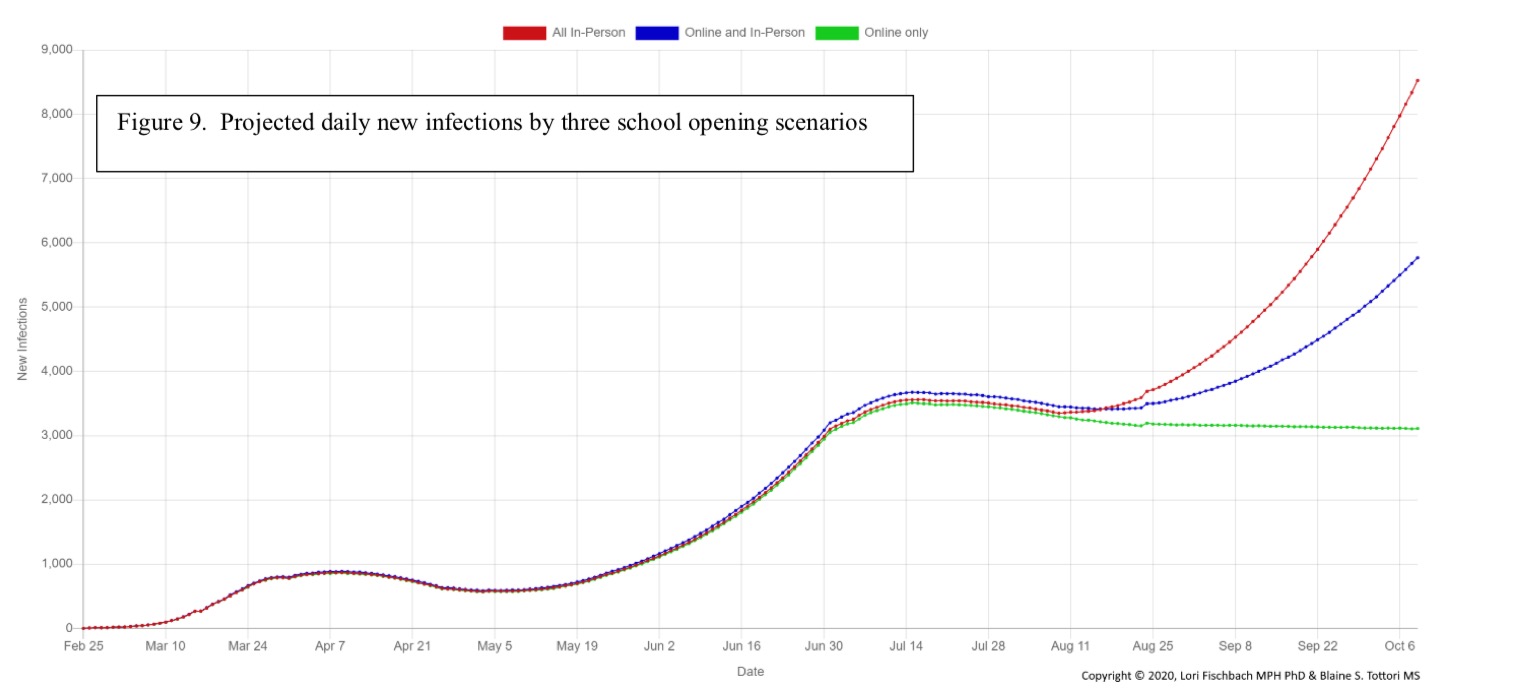What the future looks like in the state of Arkansas in regards to COVID-19 varies widely depending on how the states schools handle reopening this fall, and whether or not Arkansans comply with the mask mandate recently put into place by the governor, according to new modeling released Tuesday.
Mark Williams, Dean of the Fay W. Boozman College of Public Health at UAMS, presented the school’s new projections in a video posted to YouTube this week (embedded above).
In short term projections prepared by the college’s faculty and scientists, UAMS is projecting 58,000 cumulative cases of COVID-19 and more than 700 deaths by Monday, Aug. 24, and that number could rise to around 100,000 cumulative cases by Sept. 30 according to the latest projections.
The same model projects 1,116 deaths by the end of September, nearly doubling the 619 deaths the state announced earlier today (Tuesday, Aug. 18).
Also as part of the new models relased today, UAMS officials looked at three scenarios for mask usage in the state. Officials looked at three scenarios, simulating no increase in compliance in face coverings in the state, moderate increase in compliance in face coverings, and maximum increase in face coverings in the coming months through Oct. 6. Williams noted the wide range of outcomes the model predicts depending on compliance with using face coverings.
“The simulation suggests the daily new infections on Oct 6. could be reduced by half if there is widespread compliance with the face mask order,” he said.

Courtesy, UAMS
The same technique was used to simulate different scenarios for opening schools, with the model examining opening with only in person classes, opening with a hybrid in person/virtual schedule, and opening with only virtual instruction.
“The simulation suggests new daily cases could be reduced by 2/3 if schools were to open with online classes only,” he said.

Courtesy, UAMS
The longterm model, after applying underlying assumptions to reflect current conditions in the state, was also released. The previous long term model, Williams said, relied on rates based on estimates of the epidemic in China. The new model reflects current infectivity rate and information from the State of Arkansas, and incorporates the recent face mask order and the impact in school opening, he said. That updated model predicts a peak of infections happening around mid-December, with around 90,550 active infections at that time. On that same date, the model predicts 2,260 Arkansans will be hospitalized.

Courtesy, UAMS
The relative change in county cases in the last two weeks show the virus beginning to spread most rapidly in some of the state’s rural counties, with Logan, Poinsett, and Fulton Counties showing a relative increase of over 200% in the last two weeks. All counties in the state, he said, have shown increasing caseloads in the last two weeks, with 38 of 75 Arkansas counties showing infection rates of more than 100 cases per 10,000 (or 1 person in 100).
The state’s infectivity rate is also higher than the national average, Williams said, with a peak of 14% coming on Aug. 6. The rate has since come down a bit to around 13%.
“This date suggests the virus is still spreading throughout the state,” he said.
UAMS also included information about hospitalizations in the state by age group since March 1.
Hospitalizations are increasing for every age group in the state, with adults 35-59 leading all other age groups. This group, Williams said, is forecast to have more than 1,500 hospitalizations by Aug. 24.
The age groups with the lowest number of hospitalizations are young adults aged 20-34, and children under the age of 19. Given the increased number of infections among these groups recently, however, UAMS officials are predicting hospitalizations among them will also increase in the next few weeks.
Communities of color continue to be disproportionally effected by COVID-19, both in terms of infections and in hospitalizations.
According to the data, African-Americans in Arkansas are about three times more likely to be hospitalized or to require intensive care than are white Arkansans. Hispanics Arkansans are more than three times as likely to be hospitalized than white Arkansans.
“As I’ve said before, and as the simulation suggests, forecases and projections are not set in stone. The future is what we make it,” Williams said. “The infectivity rate in Arkansas is too high, and for things to return to a more normal state, the infectivity rate must be decrased to less than 5%.
“The time is now for all of us to do our part. If you are tired of the precautions to mitigate viral spread, good. It probably means you are doing you are doing your part. It is not easy to be vigilant, but vigilance is necessary to protect our families, our community, and our state.”

